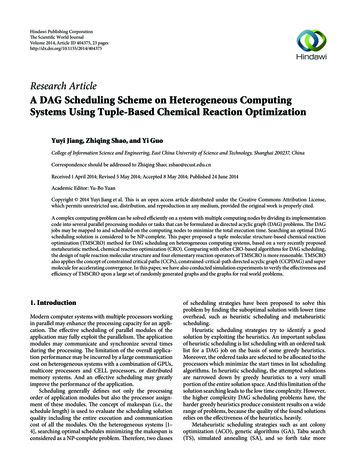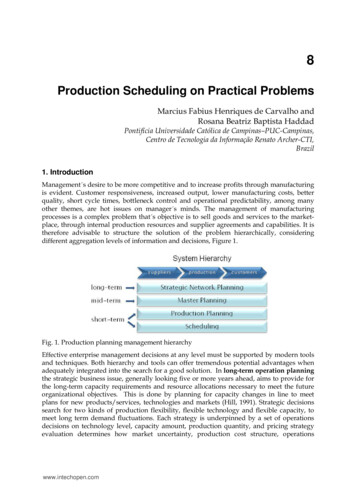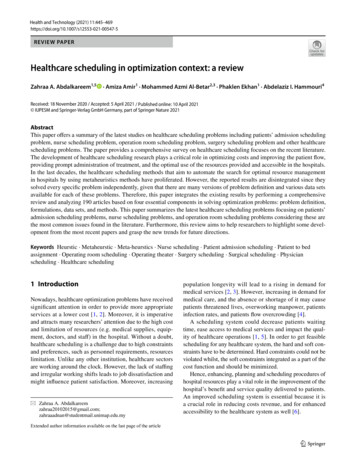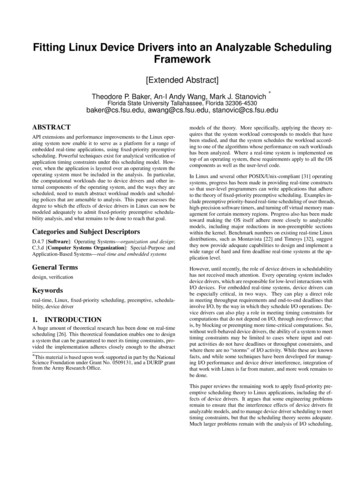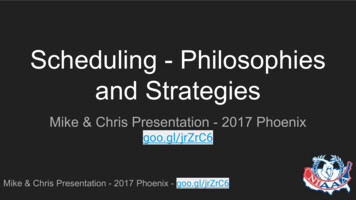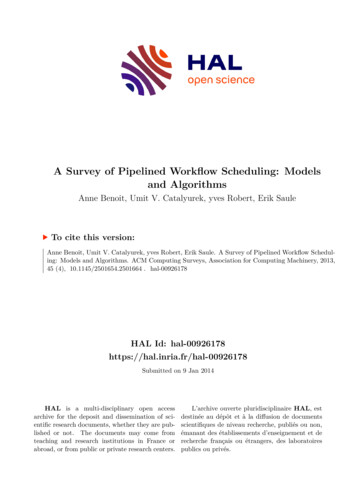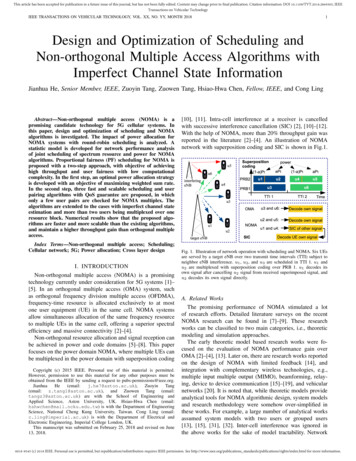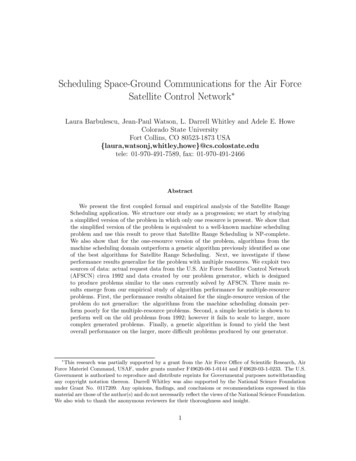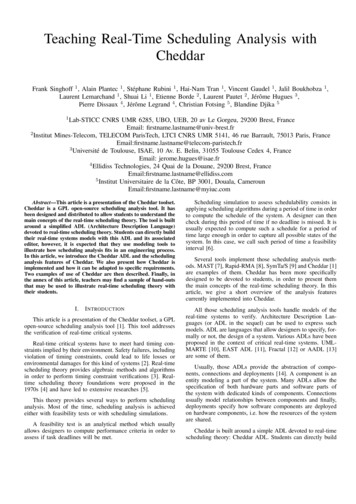
Transcription
Teaching Real-Time Scheduling Analysis withCheddarFrank Singhoff 1 , Alain Plantec 1 , Stéphane Rubini 1 , Hai-Nam Tran 1 , Vincent Gaudel 1 , Jalil Boukhobza 1 ,Laurent Lemarchand 1 , Shuai Li 1 , Etienne Borde 2 , Laurent Pautet 2 , Jérôme Hugues 3 ,Pierre Dissaux 4 , Jérôme Legrand 4 , Christian Fotsing 5 , Blandine Djika 51 Lab-STICCCNRS UMR 6285, UBO, UEB, 20 av Le Gorgeu, 29200 Brest, FranceEmail: firstname.lastname@univ-brest.fr2 Institut Mines-Telecom, TELECOM ParisTech, LTCI CNRS UMR 5141, 46 rue Barrault, 75013 Paris, r3 Université de Toulouse, ISAE, 10 Av. E. Belin, 31055 Toulouse Cedex 4, FranceEmail: jerome.hugues@isae.fr4 Ellidiss Technologies, 24 Quai de la Douane, 29200 Brest, FranceEmail:firstname.lastname@ellidiss.com5 Institut Universitaire de la Côte, BP 3001, Douala, —This article is a presentation of the Cheddar toolset.Cheddar is a GPL open-source scheduling analysis tool. It hasbeen designed and distributed to allow students to understand themain concepts of the real-time scheduling theory. The tool is builtaround a simplified ADL (Architecture Description Language)devoted to real-time scheduling theory. Students can directly buildtheir real-time systems models with this ADL and its associatededitor, however, it is expected that they use modeling tools toillustrate how scheduling analysis fits in an engineering process.In this article, we introduce the Cheddar ADL and the schedulinganalysis features of Cheddar. We also present how Cheddar isimplemented and how it can be adapted to specific requirements.Two examples of use of Cheddar are then described. Finally, inthe annex of this article, teachers may find a sample of hand-outsthat may be used to illustrate real-time scheduling theory withtheir students.I.I NTRODUCTIONThis article is a presentation of the Cheddar toolset, a GPLopen-source scheduling analysis tool [1]. This tool addressesthe verification of real-time critical systems.Real-time critical systems have to meet hard timing constraints implied by their environment. Safety failures, includingviolation of timing constraints, could lead to life losses orenvironmental damages for this kind of systems [2]. Real-timescheduling theory provides algebraic methods and algorithmsin order to perform timing constraint verifications [3]. Realtime scheduling theory foundations were proposed in the1970s [4] and have led to extensive researches [5].This theory provides several ways to perform schedulinganalysis. Most of the time, scheduling analysis is achievedeither with feasibility tests or with scheduling simulations.A feasibility test is an analytical method which usuallyallows designers to compute performance criteria in order toassess if task deadlines will be met.Scheduling simulation to assess schedulability consists inapplying scheduling algorithms during a period of time in orderto compute the schedule of the system. A designer can thencheck during this period of time if no deadline is missed. It isusually expected to compute such a schedule for a period oftime large enough in order to capture all possible states of thesystem. In this case, we call such period of time a feasibilityinterval [6].Several tools implement those scheduling analysis methods. MAST [7], Rapid-RMA [8], SymTa/S [9] and Cheddar [1]are examples of them. Cheddar has been more specificallydesigned to be devoted to students, in order to present themthe main concepts of the real-time scheduling theory. In thisarticle, we give a short overview of the analysis featurescurrently implemented into Cheddar.All those scheduling analysis tools handle models of thereal-time systems to verify. Architecture Description Languages (or ADL in the sequel) can be used to express suchmodels. ADL are languages that allow designers to specify, formally or not, the design of a system. Various ADLs have beenproposed in the context of critical real-time systems. UMLMARTE [10], EAST ADL [11], Fractal [12] or AADL [13]are some of them.Usually, those ADLs provide the abstraction of components, connections and deployments [14]. A component is anentity modeling a part of the system. Many ADLs allow thespecification of both hardware parts and software parts ofthe system with dedicated kinds of components. Connectionsusually model relationships between components and finally,deployments specify how software components are deployedon hardware components, i.e. how the resources of the systemare shared.Cheddar is built around a simple ADL devoted to real-timescheduling theory: Cheddar ADL. Students can directly build
their real-time system models with this ADL and its associatededitor. However, it is expected that they use specific modelingtools and their related ADLs to illustrate how schedulinganalysis fits in an engineering process. In this article, weintroduce Cheddar ADL and we present its main concepts.Model-Driven Engineering (MDE) [15] aims at facilitatingthe specification and the implementation of specific languages,systems and tools through the use of models.Models that can be specified not only permit precise systemdocumentation but also serve as input for automatic or semiautomatic production of the system and of its verification.In the context of the Cheddar project, the MDE is intensively used. Indeed, a significant part of Cheddar tools isautomatically generated. These tools can be used standaloneor integrated within tool-chains. Integrating our tools withinexisting tool-chains also raises interoperability issues thatmay be controled thanks to MDE processes. In this article,we explain how MDE has been applied when implementingCheddar.perform scheduling analysis techniques that we usually presentto students. Real-time systems are then modeled as a set ofentities with various attributes. For example, the concept oftask is one of the main concepts and is defined with classicalattributes such as deadline, period and capacity. An exhaustivelist of both entities and attributes is given in the Cheddar ADLuser guide [20].To support real-time scheduling theory core concepts, theCheddar ADL implements two types of entities: hardwarecomponents and software components. Hardware componentsrepresent the resources provided by the environment. Softwarecomponents model the resource requirements : they are deployed onto hardware components.Finally, having a scheduling analysis tool and a modeling language are not enough to achieve scheduling analysis.Putting scheduling analysis tools in the engineering process isalso a tedious task. In this article, we illustrate how schedulinganalysis tools can take place in a software engineering processwith two examples of use of Cheddar.Then, in the rest of this article, we first introduce CheddarADL. In section 3, a brief summary of the scheduling analysisfeatures of Cheddar is also presented. In section 4, we shortlyexplain how the Cheddar tools can be automatically producedthanks to a MDE process. Finally, two typical examples of useof the Cheddar tools are exposed in section 5.II.C HEDDAR ADL: A SPECIFIC ADL FOR SCHEDULINGANALYSISIn this section, we present Cheddar ADL, the ADL that wehave designed to model software and hardware architectures inthe specific perspective of scheduling analysis. The mainstreamADLs such as AADL [16] and MARTE [17] are very powerfulto describe real-time systems and some experiments to applyCheddar on such standard ADLs have been done [18], [19].However, for the purpose of scheduling validation, additional tools and tool-chains may be used. In fact, schedulingverifications involve not only a subset of those mainstreamADLs modeling capabilities but also require specific information or computations.Cheddar ADL and related tools are domain specific. Theirmodeling and their implementation are the results of a ModelDriven Engineering (MDE) process tooled with a specificinfrastructure. Whereas the use of the MDE facilitates thebuilding of new releases of Cheddar ADL and of our existingtools, it also facilitates the building of new tools.In the sequel, we first define the concepts introduced by thisADL. Then, we describe scheduling analysis that are expectedto be run on models expressed with Cheddar ADL.Basically, the main concepts manipulated through CheddarADL come from the real-time scheduling theory. The onlypurpose of Cheddar ADL is to model the concepts required toFig. 1.Cheddar ADL main hardware components.Cheddar provides limited capabilities to model hardwarecomponents. Indeed, real-time scheduling theory usually assumes simple models of hardware. On the contrary, softwareparts of a system are modeled in a more detailed way.As shown in Figure 1, hardware components can be ofthree kinds. (1) Core components model entities providinga resource to sequentially run flows of control. (2) Cachecomponents model memory caches related to one or severalcores. (3) Processors components are composed of sets ofcores and caches.Software components can be deployed on either core orprocessor components. Those deployments model two kinds ofcomponent connections that allow designers to express eitherglobal scheduling or partitioned scheduling [21]. The designof the software part of a real-time system can be specified withfive component types. These component types are depicted byFigure 2. (1) Address space components model a group ofresources that can be accessed. They may be associated toan address protection mechanism. (2) Task components modelflows of control. They are statically connected to addressspace components. (3) Resource components may model anydata structure, shared by tasks or not, synchronized or not.They may be accessed through classical priority inheritanceprotocols such as PCP [22]. They may model asynchronous
reaction wheels, magnetic torquers, thrusters, and solar arrayand trim tab positioners.This AOCS is composed of several tasks:Fig. 2.RW Data Task: the Reaction Wheels (RW) actuatorcontrols the movement of the spacecraft. DSS Data Task: the Digital Sun Sensor (DSS) keepstrack of the spacecraft’s orientation in relation to theposition of the sun. Gyro Data Task: the Rate Gyro Sensor detects therotation of the spacecraft; this sensor data is sporadicbecause normally it has a different clock rate so thedata can contain some jitter. Command Actuators Task: applies a set of commands defined by the Control Law task to keep thespacecraft in its orientation and pointing. Control Law Task: implements the basic controllaws and is therefore responsible for maintaining thespacecraft orientation to a defined point. IRES Data Task: the InfraRed Earth Sensor (IRES)scans a large field of view and then detects signals atthe Earth/Space transitions.Cheddar ADL main software components.communications between tasks located in the same addressspace. Resource components are statically connected to address space components. (4) Buffer components model queuedasynchronous data exchanges between tasks located in thesame address space. (5) Message components model queuedasynchronous data exchanges between tasks located in different address spaces. Buffer, resource and message componentsspecify types of connection between components, i.e types ofdependencies between tasks. c o r e u n i t i d ” 16 ” name c o r e 1 /name s c h e d u l e r t y p e POSIX 1003 HIGHESTPRIORITY FIRST PROTOCOL / s c h e d u l e r t y p e p r e e m p t i v e t y p e PREEMPTIVE / p r e e m p t i v e t y p e . . . m o n o c o r e p r o c e s s o r i d ” 17 ” name Soc Leon4 /name c o r e r e f ” 16 ” / . . . p e r i o d i c t a s k i d ” 19 ” name RW Data /name cpu name Soc Leon4 / cpu name c a p a c i t y 2 / c a p a c i t y d e a d l i n e 200 / d e a d l i n e p e r i o d 200 / p e r i o d . . . s p o r a d i c t a s k i d ” 20 ” name Gyro Data /name . . . p e r i o d i c t a s k i d ” 21 ” name DSS Data /name . . .Fig. 3. The software part of this example is composed of severalperiodic and sporadic tasks. For example, tasks RW Dataand DSS Data are periodic while Gyro Data is sporadic.They are all defined by their respective period, capacity anddeadline. The hardware part only models a processor (calledSoc Leon4) including two cores (called core1 and core2).III.A NALYSIS FEATURES PROVIDED BY C HEDDARFrom a Cheddar ADL model, real-time scheduling theory provides various ways to perform scheduling analysis:verifications can be performed either with feasibility tests orwith scheduling simulations on the feasibility interval. Cheddarimplements classical methods of both verification techniques inorder to illustrate to the student how scheduling analysis canbe driven. In this section, we first introduce feasibility testsimplemented into Cheddar and then, we present its schedulingsimulation features.Example of a Cheddar ADL model for the AOCS system.Figure 3 shows a simple model of a real-time systemspecified with the Cheddar ADL. This is a model for thescheduling analysis of an Attitude and Orbital Control System(AOCS) of a spacecraft case study [23], [24]. An AOCSmaintains the spacecraft orbit and ensures the spacecraft isoriented to achieve the expected functionality. This subsystemconsists of a set of redundant sensors and actuators such assun/star and earth sensors, gyroscopes, momentum wheels,Fig. 4.Scheduling analysis of the AOCS system by Cheddar.
A. Scheduling analysis with feasibility testsOne of the very first feasibility tests usually presentedto students is the Liu and Layland feasibility test for uniprocessor real-time systems [4] based on equation (1):U nXCii 1Pi(1)This equation computes the processor utilization factorU . In the context of a fixed priority preemptive schedulingpolicy with priorities assigned according to Rate Monotonic, n1 1) then the system, under the Liu andif U n(2Layland conditions, is schedulable, i.e. all tasks will meet theirdeadline. For this type of architecture, this feasibility test is asufficient but not necessary schedulability condition.The Cheddar tool implements various feasibility tests.Processor utilization feasibility tests can be applied on otherscheduling policies. Furthermore, worst case response timecan be computed on periodic tasks, organized or not inlinear/graph transactions [25]. Those worst case response timecan integrate delays related to shared resources (i.e. sharedresource blocking time [22]). Finally, few feasibility tests forhierarchical architectures have also been implemented in orderto explain to students the main concepts of compositionalanalysis [26].As an example, the AOCS system described in Figure 3 iscompliant with the feasibility test presented in [27]. Applyingthis feasibility test leads to the result presented in Figure 4.It is not possible to analyze all systems by feasibilitytests, and some theoretical results are often known as beingtoo pessimistic. That’s why additional techniques such assimulation can help to increase the confidence the designerhas on his/her design. We discuss this issue in the sequel.B. Scheduling analysis with simulationsCheddar implements several classical scheduling algorithms. Students may experiment classical schedulers suchas Rate Monotonic, Deadline Monotonic, EDF, LLF, MUF,POSIX 1003 policies, both preemptive and non preemptive.Those algorithms have been implemented in the context ofuniprocessor scheduling and also in the context of globalmultiprocessor scheduling. Global scheduling is also illustratedto the student by a specific global multiprocessor scheduling(e.g. Proportionate Fair [28]) and two task migration policies.The tool also implements non real-time policies (i.e. roundrobin and time sharing policies) allowing the students tocompare and understand specificities of real-time schedulingpolicies. Furthermore, hierarchical scheduling is illustrated byan implementation of the ARINC653 scheduling policies andseveral classical aperiodic servers (deferable, sporadic, priorityexchange).Scheduling simulations can be run for usual task modelssuch as periodic, aperiodic, sporadic, GMF tasks or task released according to a Poisson process. Tasks can be constrainedby dependencies related to shared resources, precedence orcommunication task relationships. Tasks may also be organizedin linear or graph transactions. Again, classical policies havebeen implemented for the students. For example, a studentcan design architecture models with PIP, ICPP, PCP or FIFOshared resource protocols. During the design phase, he canalso experiment various priority assignment algorithms such asRate Monotonic [4], Deadline Monotonic [29], the Audsley’salgorithm [30] or one devoted to architectures with caches [31].From an architecture model, various performance criteriacan be extracted from scheduling simulation: worst/best/average response time, probability distribution of response time,worst/best/average shared resource blocking time, number ofcontext switch or preemption, deadlock, priority inversion orspecific properties defined with a domain specific language.Furthermore, specific schedulers or task models can be alsospecified with the help of the Cheddar ADL. Those specificschedulers allow users to extend the scheduling analysis capability without a deep understanding of Cheddar design andimplementation. This feature allows users to quickly adapt thescheduling verification tool to their needs (i.e. implementing ascheduling method which does not exist yet in Cheddar).In the sequel, we show how to implement such specificschedulers with Cheddar. Equation 2 specifies a Density valuescheduler [32] which does not exist in the current implementation of Cheddar.P riority(i) V alue at time(i)/Computation time (2)Figure 5 shows the implementation of this scheduler withthe Cheddar ADL and how such a user-defined schedulercan be used to define a new processor type with our AOCSexample. With this architecture model, algorithm of Figure 5is supposed to be stored in a separate file called aocs dvs.sc.Basically, the priority section expresses how prioritieshave to be computed at each unit of time during simulationand election section describes how to select the task to runwhen priorities have been computed: here, we select the taskwith the highest aocs dvs priority priority.start section :a o c s d v s p r i o r i t y : array( tasks range ) of integer ;i : integer ;end s e c t i o n ;priority section :for i in t a s k s r a n g e loopaocs dvs priority ( i ): tasks . value ( i ) /tasks . rest of capacity ( i );end l o o p ;end s e c t i o n ;election section :r e t u r n max to index ( a o c s d v s p r i o r i t y ) ;end s e c t i o n ;Fig. 5. Example of a Cheddar program modeling a Density value scheduler.Those statements are activated by an automaton during scheduling simulations.
C. ConclusionIn this section, we have presented the main analysis features implemented into Cheddar. Scheduling analysis can beperformed either with feasibility tests or scheduling simulation.Some of the features of Cheddar have not been described here.The tool also provides various methods to assign priorities orto perform partitioning. All those features are described in theCheddar user-guide ntationCheddarADL metamodels inEXPRESSIV.M ODEL - DRIVEN PROCESS OF C HEDDARNew hardware elements and products continuously ariseand have to be taken into account during the verification ofreal-time systems. As a consequence, ADL based tools thatare used for the early verification of real-time systems areoften specific tools and are often subject to changes. This istypically the case of Cheddar ADL.To help keep Cheddar up-to-date according to use-cases,a model driven process is used to automatically build a partof the tool. In this section, we describe how some parts ofCheddar are automatically produced from its meta-models. Wefirst describe how the infrastructure of Cheddar is specified,validated and automatically generated through the use of ameta-workbench. Then we focus on a more specific generatingprocess regarding the automatic implementation of specificschedulers.A. The Cheddar building processAs it is depicted in Figure 6, Cheddar is also a targetsystem that must be specifically specified, validated and builtthrough the use of a meta-workbench. Figure 6 shows twodashed ellipsis which represent two iterations:1)2)The inner iteration ellipsis is for the early validationof timing constraints of the target system through theuse of Cheddar.The outer iteration ellipsis is for the specification,the validation and the generation of Cheddar itself.Here, the process is twofold. First, the validation ofthe meta-specifications must be achieved [33]. Themeta-specifications are made of the Cheddar ADLmeta-model (see Figures 1 and 2), of the Cheddarlanguage meta-model and of code generators. Thenlate validation is processed through the use of Cheddar as explained in point 1.Thanks to the MDE, a part of Cheddar is automaticallygenerated from its meta-models. The generated part includesTargetsystemAnalyserCheddarADL torCheddarHowever, using the Cheddar ADL alone remains difficultfor architecture designers. Indeed, Cheddar ADL concepts arevery close to real-time scheduling theory which may be notusual concepts for architecture designers. Furthermore, as thereal-time scheduling theory, the ability of Cheddar ADL tomodel hardware and operating system parts is limited.In practice, it is expected that architecture designers perform the modeling activity with separate systems or softwareengineering tools using standard modeling language such asAADL or MARTE. The Cheddar ADL used together withmainstream languages can offer extended modeling and validation capabilities. We discuss this issue in the next sections.CheddarADL modelMeta-metamodelsimplementationAnalyserCheddar ADLmeta-modelsinternalCoderepresentation generatorTarget Meta-Workbench (Platypus)CompilingFig. 6.ParsingCode generatingRepresents aspects ofThe MDE process for the building of Cheddar.the meta-models entities implementation (i.e. correspondingclasses), a repository which is used to store and manageCheddar ADL models internal representations and a CheddarADL model exchange component.The meta-workbench Platypus [34] is used to implementthe code generators. All our meta-models, domain rules andcode generators are specified with the general purpose datamodeling language EXPRESS [35].B. Building a specific schedulerAs we briefly describe in section III-B, in order to runsimulations, Cheddar provides a set of real-time schedulers andtheir analysis tools. Some schedulers are already present intoCheddar. Cheddar being implemented in Ada, those schedulersare also implemented in Ada.Specific schedulers or task models can be also implemented. A specific scheduler can be written either in Ada orwith the Cheddar ADL (an example of a specific scheduleris shown in Figure 5). Manually implementing a specificscheduler in Ada is a tedious and error prone task. Using theCheddar ADL helps the designer as he has only to deal withhigh-level and simpler concepts. As it is depicted in Figure 7,with the Cheddar ADL, the process of implementing a specificscheduler is made of three steps. (1) The scheduler is specifiedby an automaton with the Cheddar ADL. Figure 5 shows a partof such specification. (2) An interpreter of such automaton ismade available as a Cheddar tool. This interpreter is usefulto validate the specific scheduler. However, running specificschedulers this way can be very time consuming. (3) In orderto speed up the running of a scheduler, the correspondingAda code can be automatically produced from the specificationof the scheduler written in the Cheddar ADL (the schedulerautomaton). The generated Ada code is integrated and anew version of the Cheddar tools including the new specificscheduler is then produced [36].C. ConclusionSupporting MDE with a comprehensive tool environmentis crucial, as many of the techniques promoted as necessary in
torSpecificScheduler(3)Scheduler generatorCheddarParsingFig. 7.them be properly processed by various analysis or productiontools. Although AADL Inspector uses the AADL standard asa base reference for its input models, it can also process UMLprofiles such as SysML and MARTE or be coupled to graphicaleditors such as the Stood tool. In the case of Cheddar, the inputmodel is converted into a corresponding representation in theCheddar ADL that has been presented before. Then, the resultsof the analysis, either coming from the feasibility tests or thesimulation, are processed by the AADL Inspector GraphicalUser Interface.Code generatingThe MDE process for the building of a specific scheduler.MDE strongly depend on proper tool support [37]. Having awell defined ADL helps in the building of a trusted real-timesystem because it can serve as the core element for the toolsthat are implemented in order to verify it. However, havingwell defined ADL is just not enough. A complete and workingMDE environment must be used for the building of verificationtools. Moreover, reliable code generators must be specified andinteroperability between tools must be ensured.The major difficulty lays in the specification of the metamodels at the right abstraction level. Moreover, defining reliable specific meta-models is a long and costly task becauseof the verification and the validation process that impliestools building and adapting (specification of code generators,refactoring of the analysis tools, .). Another difficulty is theintegration of the generated code when Cheddar is embeddedin a tool chain. Indeed, it may be difficult to anticipate what arethe needs of the other tools. In the next section, we present twoexamples of tool chains embedding Cheddar where integrationis achieved thanks to AADL.V.I NTEGRATION OF C HEDDAR IN AADL I NSPECTORAND THE TASTE TOOL - CHAINAs it has been explained in the previous sections, Cheddarhas been initially designed to be used as a standalone toolfor an academic usage. In that respect, it includes its ownGraphical User Interface to enter real-time models and displaythe scheduling analysis results. Nevertheless, such a tool canalso be highly profitable for industry oriented environmentsand modeling languages. This however requires a more modular usage of the tool and the development of additionalcomponents to interface it to this new context. This is whathas been done to integrate Cheddar as an analysis plug-in ofthe AADL Inspector tool, and of the Concurrency View editorof the TASTE tool-chain (TASTE-CV).In order to be able to use Cheddar as an analysis backendwhile minimizing the interfacing issues, the Graphical UserInterface and some model input features have been separatedfrom the main scheduling analysis module. The result of thisengineering operation is a subset of Cheddar called CheddarKernel that can easily be integrated within a system orsoftware development environment. The containing tool mustthus provide new control and data interfaces with the user.AADL Inspector (see Figure 8) is a model processingframework that embeds a set of generic features to load realtime models and convert them into the appropriate format to letFig. 8.AADLInspector embedding Cheddar.AADL Inspector embeds other analysis plug-ins, and inparticular the Marzhin event-based simulation engine thatcomplements the timing analysis by adding a capability toobserve the behavior of non periodic systems. During theSMART collaborative project [38], Cheddar has been usedas a reference tool to calibrate the Marzhin simulator. Fora set of input model test cases where the two tools couldprovide a significant result, an automatic comparison of thetwo simulation traces has been implemented for that purpose.TASTE is a software development tool-chain that is developed by the European Space Agency and a team of subcontractors [39]. TASTE supports a well defined design processfor embedded applications in the space domain. This processincludes modeling, verification, generation and testing phasesthat are supported by dedicated tools. The scheduling analysisphase is insured by the TASTE-CV tool which includesCheddar in a similar way as AADL Inspector does.These examples show that Cheddar can also be profitableto bring the benefit of early scheduling analysis into industrialdevelopment environments and processes. The next section describe another use of Cheddar in a code generation framework.VI.RAMSES: AADL M ODELS R EFINEMENT ANDS CHEDULING A NALYSISRAMSES1 is a model-to-model transformation frameworkwhere both input and output models are based on AADL [40].In MDE, model transformations play an important role:they formalize in reusable artefacts (i.e. model transformationsource code), the implementation of recurrent design patterns(e.g. safety or security design patterns), design decisions (e.g.1 Refinementof AADL Models for Synthesis of Embedded Systems
deployment of software components on hardware components), or model refinements (e.g. transformation steps towardscode generation). Model refinements were first implemented inRAMSES in order to evaluate the impact of code generationpatterns on Non-Functional Properties (NFP) of a real-timeembedded system. Figure 9 gives an overview of RAMSES.The execution of RAMSES starts with (i) an input model, (ii) aselected platform (among platforms supported by RAMSES),and (iii) a selected set of analysis methods. The current version of RAMSES supports ARINC653 and OSEK compliantplatforms.in each scheduling scenario. Launching AADL Inspector withits graphical interface was also practical in order to verify thecontent of models used for analysis.The approach implemented in RAMSES has als
environmental damages for this kind of systems [2]. Real-time scheduling theory provides algebraic methods and algorithms in order to perform timing constraint verifications [3]. Real-time scheduling theory foundations were proposed in the 1970s [4] and have led to extensive researches [5]. This theory provides several ways to perform scheduling
